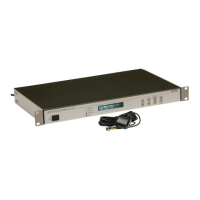4.4 Technical Details on GPS, Antennas and Cables 23
Adjacent Signals
Although the standard RG-6 style cable is triple-shielded and has excellent shielding properties,
be cautious when routing near sources of high RF power, or alongside cables carrying high power
RF, such as transmitter cables. In these applications, consider using RG-11 style cable (P/N
WC0004900). Its quad-shielded design provides even more isolation.
Antenna Power
The RF preamplifier within the antenna requires 5 Vdc at 13 mA maximum for operation. A
power supply within the clock generates this voltage, which is applied to the antenna via the two
conductors of the coaxial antenna cable. Avoid shorting the center conductor to the shield of the
coaxial cable as it may damage the preamplifier. Conversely, a high-resistance connection or open
circuit would deprive the preamplifier of power. Either a short- or open-circuit condition in the
antenna cable will render the clock inoperable.
Prior to initial operation or if problems are suspected, perform the Antenna/Cable Operational
Test Procedure described in Section 4.2.
Connection to Antenna
The male Type F connector on one end of the antenna cable mates with the female Type F connector
on the antenna. Avoid placing mechanical stress on the cable attachment to the antenna.
Connection to Clock
The male Type F connector on the opposite end of the antenna cable connects to the female Type
F connector on the rear panel of the substation clock.
User-Supplied Antenna Cables
Any RF cable meeting the requirements described above for loss (< 21 dB at 1575 MHz) and dc
resistance (< 15 ohms total loop resistance) may be used with the clock. However, prior to using
a non-standard antenna cable, verify proper operation before installation.
For additional technical details concerning the GPS, GPS antennas and antenna cabling see
Appendix A, Technical Details and Specifications.

